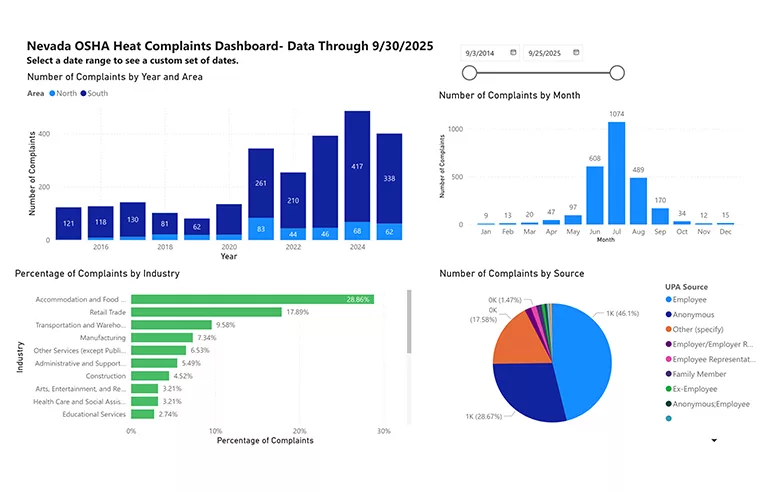
Photo: Nevada Division of Industrial Relations and Nevada OSHA
Carson City, NV — The Nevada Division of Industrial Relations and Nevada OSHA have updated their heat illness dashboard to include data on the state’s newly implemented heat rule.
In effect since April 29, the regulation is aimed at protecting indoor and outdoor workers from excessive heat. The new data provides insights into awareness and enforcement of the regulation. That includes data on complaints, inspections, citations, penalties and workers’ compensation.
Nevada OSHA reports that, as of Oct. 15, 183 inspections related to compliance with the heat rule have been recorded. The three top inspected industries were accommodation and food services (19%), construction (18%), and retail (11%).
Other insights:
- Since enforcement began, 13 noncompliance citations have been issued. Some establishments didn’t receive a monetary penalty, while others received an average penalty of $14,900.
- Nevada OSHA has received 400 complaints, a nearly 20% reduction from 2024. Employees (49%) were the top source of complaints.
- The top three industries with the highest percentage of complaints were accommodation and food services (25%), retail (19%), and transportation and warehousing (10.5%).
The regulation requires employers with at least 10 employees to conduct a one-time job hazard analysis to identify work conditions that could cause a heat-related illness. If conditions are identified, a written safety plan must be developed and include provisions for potable water, means of cooling workers, monitoring, worker training and emergency response procedures, among others.
“The first year of enforcement has shown that many Nevada businesses are taking the regulation seriously,” DIR Administrator Victoria Carreon said in a press release. “By implementing preventive measures and training programs, employers are helping to create safer work environments and protect employees.”
Nevada OSHA, which operates under federal OSHA’s State Plan program, urges all employers to review workplace policies and provide appropriate training. For Nevada employers with more than 10 workers, DIR’s Safety Consultation and Training Section provides free training and consultation.
McCraren Compliance offers many opportunities in safety training to help circumvent accidents. Please take a moment to visit our calendar of classes to see what we can do to help your safety measures from training to consulting.
Original article published by Safety+Health an NSC publication